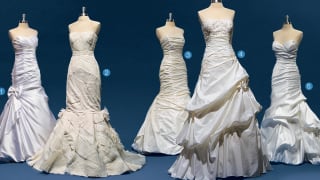Consumer Reports' secret shoppers across the country and in our Yonkers, N.Y., headquarters worked for several weeks in late winter to compare prices of wedding services. We wanted to see whether caterers, photographers, and other vendors would charge more for their services if they were told the event being planned was a wedding rather than a 50th-wedding-anniversary party. We believed the results would provide an anecdotal snapshot of what consumers might experience when planning a wedding.
For geographic diversity, we identified five locations: Atlanta; Colorado Springs, Colo.; southeastern Maine; Minneapolis; and Ventura, Calif. We randomly located vendors in those areas—bakeries, caterers, florists, limousine services, photo-booth-rental services, and photographers—mainly through wedding websites and online searches.
Using a phone number that wasn't identifiable with Consumer Reports, a secret shopper called each vendor and asked for pricing for a Saturday-night wedding in mid-October. Within a few weeks, other secret shoppers using different phones called the same vendors and asked for the same services for a 50th-wedding-anniversary party for the same date and time. We then compared the quotes from vendors.
We supplemented that comparative test with pricing research in several other locations, including Illinois, Missouri, New Jersey, New York, Pennsylvania, South Carolina, and Texas. In all, we gathered prices from 40 vendors in 12 states.
More on Weddings
Creating Party Parity
Of course, a wedding can be very different from other types of parties. So we were specific in the parameters we gave the secret shoppers to better ensure that the quotes were for identical services.
- Photography: We told vendors that the marriage ceremony was taking place on a different day than the reception, so we needed a photographer only for the four-hour party, not for other pre-wedding events. Similarly, for the anniversary we asked for photographs for the party only.
- Caterer: For both the anniversary party and wedding, we requested a quote for a moderately priced, four-hour, sit-down meal for 100 people with a cocktail hour and passed hors d'oeuvres.
- Limousine: For the wedding, we stipulated just a one-way ride from the bride's house to the reception. We gave similar instructions for the anniversary party: A one-way ride to the venue from the couple's home.
- Flowers: We asked for table centerpieces only, not for bouquets or other arrangements, noting that those would be supplied by someone else. We asked for moderately priced options but were not specific about the types of flowers we wanted.
- Photo booth: We asked for a booth for four hours for both parties.
- Cake: A simple sheet cake to serve 100 people, decorated with a few flowers made of icing, was requested for both events.
Details on Our Wedding Survey
In February 2016 the Consumer Reports National Research Center conducted a national online survey of 464 recently married couples to assess opinions and behaviors regarding wedding-reception spending and how the couple saved up for the big event.
We administered a survey to a sample of 5,000 U.S. adult U.S. residents from February 12-18, 2016. The sample was 48 percent male and 52 percent female with an average age of 47. Though this larger group provided our results on wedding gift-giving habits, we focused mainly on the 464 respondents who told us they'd had a wedding reception in the past five years. This sample was 57 percent male and 43 percent female with an average age of 34. This group informed our survey results on wedding-related planning, spending, and saving behavior.

Wedding Gown Price Challenge
In late February 2016 we rented or borrowed five recent-vintage wedding gowns, gently used or new, with estimated retail values of $500 to $10,000, according to the companies that supplied them—Borrowing Magnolia and Nearly Newlywed.
We then asked colleagues at our headquarters—regular folks who are generally not fashionistas—to match the gowns with their retail values. (We did our best to choose dresses of similar style so that personal preference wouldn't enter into the judgments.) We let our amateur judges view the gowns and touch their fabric, but not look inside for labels or otherwise handle the garments (we insisted they wash their hands first). Eighty-nine women and 54 men participated.
Our textile expert Pat Slaven also examined the gowns' construction, inside and out.





















